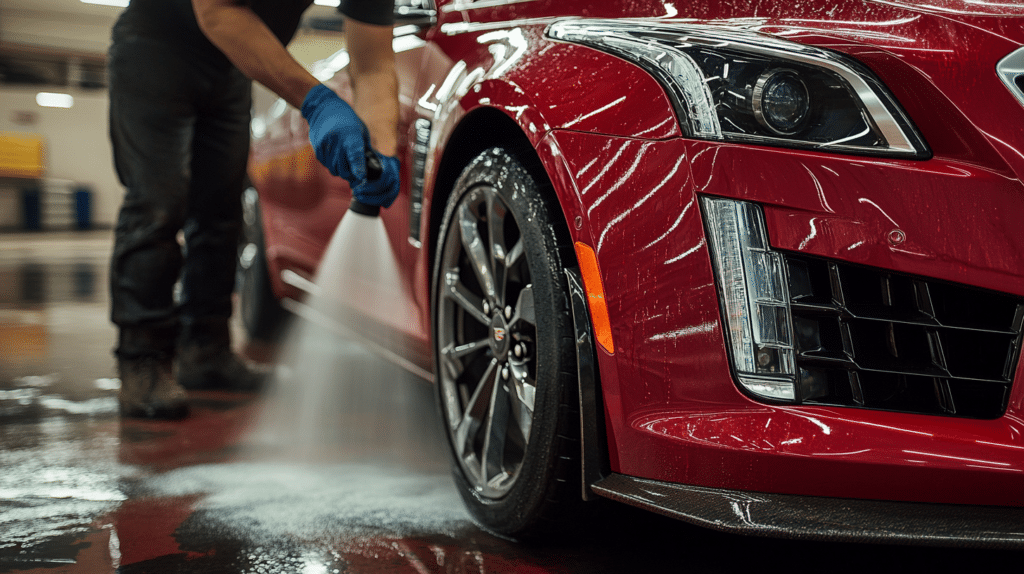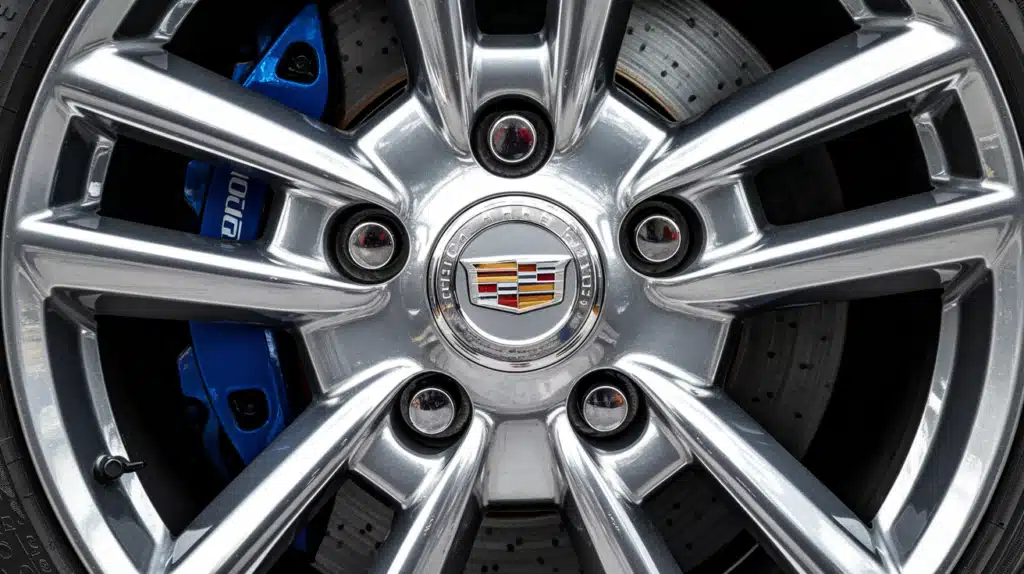Finding the right wheel fitment for your Cadillac can feel frustrating. Many car owners struggle with bolt patterns, offset measurements, and hub sizes when looking for new wheels.
You’ll get all the details about Cadillac bolt patterns in this guide.
We break down the measurements by model year and show you how to check your specific pattern.
This article covers the standard bolt patterns for every Cadillac model from 1950 to today.
You’ll learn how to measure your bolt pattern, understand wheel offset, and find hub-centric rings if needed.
We also include quick tips to avoid common wheel fitment mistakes.
What is the Bolt Pattern for a Cadillac?
But first, what is a bolt pattern?
A bolt pattern tells you how many lug holes are on your wheel and how far apart they are. Think of it as a circle with dots spread evenly around it. These dots show where the bolts go through your wheel into the hub of your car.
The pattern has two main numbers:
- The first number shows how many bolts hold your wheel
- The second number tells you the diameter of the circle made by the bolts
For example, if you see “5x115mm,” this means:
- 5 bolts secure the wheel
- The circle they make is 115 millimeters across
Common Cadillac Bolt Patterns
Here’s a Helpful Chart Showing Bolt Patterns for Popular Cadillac Models:
| Year | Model | Bolt Pattern |
|---|---|---|
| 2015-2023 | Ct4 | 5x115mm |
| 2020-2023 | Ct5 | 5x115mm |
| 2013-2023 | Xts | 5x115mm |
| 2015-2023 | Escalade | 6×139.7mm |
| 2004-2019 | Cts | 5x120mm |
| 2013-2023 | Ats | 5x115mm |
Why Correct Bolt Patterns Matter
Using the right bolt pattern is essential for three main reasons:
- Safety: Wheels must fit perfectly to stay secure while driving
- Performance: Wrong patterns can cause shaking and poor handling
- Cost savings: You avoid buying wheels that won’t fit your car
When changing wheels, measure your current bolt pattern or check your car’s manual. This helps prevent costly mistakes and keeps you safe on the road.
Understanding Cadillac Bolt Patterns and Their Compatibility

Key Components of a Bolt Pattern
A Bolt Pattern Combines Two Essential Measurements: the Lug Count and the Pitch Circle Diameter (pcd). The Lug Count Indicates the Number of Bolts that Secure Your Wheel in Place. The Pcd Represents the Distance Between Opposite Bolts, Measured in Millimeters.
Most Cadillac Sedans Use a 5x115mm Pattern, While SUVs Like the Escalade Use 6×139.7mm. Older Cts Models Typically Feature a 5x120mm Pattern. to Measure Your Pcd on a 5-Lug Wheel, Measure from the Center of One Bolt to the Outside Edge of the Bolt Farthest Away.
For 6-Lug Wheels, Measure from the Center of One Bolt to the Center of the Opposite Bolt.
Cadillac Bolt Pattern Reference Chart:
| Model Line | Years | Bolt Pattern |
|---|---|---|
| Ct4/ct5 | 2020-2023 | 5x115mm |
| Ats | 2013-2019 | 5x115mm |
| Cts | 2014-2019 | 5x115mm |
| Cts | 2008-2013 | 5x120mm |
| Escalade | 2015-2023 | 6×139.7mm |
| Xts | 2013-2019 | 5x115mm |
Center Bore Measurements for Cadillac Models
The center bore serves as a critical wheel fit point on your Cadillac. For proper installation, this central hole in your wheel must match precisely with your vehicle’s hub. Different model years use specific sizes that changed as designs evolved.
Current Cadillac vehicles, made from 2015 to 2023, all share a standard 70.3mm center bore size. This uniform measurement makes wheel selection simpler across the modern lineup.
From 2010-2014, models like the ATS, CTS, and XTS used a slightly smaller 66.9mm center bore.
Going back in time, Cadillac models from 2000 to 2009, including the CTS, STS, and DTS, featured an even smaller 63.4mm center bore.
This size difference means wheels from newer models won’t fit older vehicles without proper hub rings. Each size change marked improvements in Cadillac’s wheel mounting designs.
This measurement proves essential for wheel fitment. A matching center bore helps your wheel sit perfectly centered on the hub. You get better balance and a smoother ride when these measurements align correctly.
The right fit prevents vibration issues and ensures even weight distribution across your wheels.
Factors that Determine Compatibility
The proper fit of your Cadillac wheels depends on three key measurements. The offset determines how your wheel sits in relation to the suspension components.
This measurement affects both clearance and handling characteristics.
The Pitch Circle Diameter, or PCD, shows the exact spacing between your bolt holes, ensuring secure mounting points.
The hub size guarantees your wheel centers perfectly on your vehicle, preventing vibration and wear.
Each measurement plays a vital role in how your wheels perform. A correct offset keeps your wheels within the fender lines while maintaining proper suspension geometry.
The right PCD ensures your wheel mounts securely to your vehicle. A matching hub size prevents wobble and maintains even weight distribution.
List of the Correct Bolt Pattern for Different Cadillac Models
Bolt Patterns for Sedans
Cadillac sedans have used several bolt patterns throughout their production years. The older models like the Allante used different patterns compared to modern vehicles.
From the 1990s through the early 2000s, most Cadillac sedans featured a 5x115mm pattern. The DeVille series maintained this pattern throughout its production run.
Cadillac Sedan Bolt Pattern Chart:
| Model | Years | Bolt Pattern | Center Bore |
|---|---|---|---|
| Allante | 1987-1993 | 5x115mm | 70.3mm |
| CTS | 2003-2007 | 5x120mm | 66.9mm |
| CTS | 2008-2023 | 5x115mm | 70.3mm |
| DeVille | 2000-2005 | 5x115mm | 70.3mm |
| CT4 | 2020-2023 | 5x115mm | 70.3mm |
| CT5 | 2020-2023 | 5x115mm | 70.3mm |
| ATS | 2013-2019 | 5x115mm | 70.3mm |
Bolt Patterns for SUVs and Trucks
Cadillac SUVs and trucks typically use larger bolt patterns than their sedan counterparts. The Escalade series has maintained a consistent 6×139.7mm pattern since its introduction.
This larger pattern provides extra stability for these heavier vehicles. The SRX crossover used the sedan-style 5x115mm pattern to match its car-based platform.
Cadillac SUV/Truck Bolt Pattern Chart:
| Model | Years | Bolt Pattern | Center Bore |
|---|---|---|---|
| Escalade | 1999-2023 | 6×139.7mm | 78.1mm |
| SRX | 2004-2016 | 5x115mm | 70.3mm |
| XT4 | 2019-2023 | 5x115mm | 70.3mm |
| XT5 | 2017-2023 | 5x115mm | 70.3mm |
| XT6 | 2020-2023 | 5x115mm | 70.3mm |
High-Offset vs. Low-Offset Models Explained
Cadillac designs each model line with specific offset requirements that match their unique purposes and builds. Offset plays a vital role in wheel placement, affecting both performance and safety. Understanding these differences helps you select the right wheels for your vehicle.
Luxury sedans in the Cadillac lineup, such as the CT4, CT5, and CTS, need higher offset measurements ranging from +35mm to +45mm. These higher values keep the wheels properly tucked under the fenders while maintaining sufficient brake clearance.
The performance-focused V-Series models use slightly lower offsets, between +30mm to +40mm, to create the perfect balance of handling and stability.
Moving to the larger vehicles, Cadillac SUVs and crossovers like the standard Escalade and XT5 work best with offsets from +25mm to +35mm. These lower values account for their wider stance and different suspension geometry.
The performance-oriented Escalade V splits the difference, requiring offsets between +30mm and +40mm to handle its increased power and special suspension setup.
When looking at aftermarket wheels, these offset ranges become crucial. Sedans require careful attention to higher offset values for proper component clearance. In contrast, SUVs offer more flexibility with lower offsets thanks to their roomier wheel wells and suspension design.
This variation in offset needs reflects each vehicle’s specific engineering requirements.
How to Identify the Correct Bolt Pattern for a Specific Cadillac Model
Tools Required for Measuring Bolt Patterns.
The right tools help ensure accurate bolt pattern measurements. Here’s what you’ll need:
Essential Measurement Tools Chart:
| Tool | Purpose | Precision Level |
|---|---|---|
| Measuring Tape | Basic PCD measurement | Medium |
| Digital Caliper | Precise bolt circle measurement | High |
| Bolt Pattern Gauge | Quick pattern verification | High |
| Center Bore Gauge | Hub size measurement | High |
| Ruler/Straight Edge | Basic measurements | Low |
| PCD Measurement Tool | Professional-grade accuracy | Very High |
Steps to Measure PCD on Even and Odd Lug Configurations.
For 5-lug wheels,
start by measuring from the center of any lug to the outer edge of the second lug (clockwise or counterclockwise). This gives you the measurement needed to calculate the bolt circle. Multiply your measurement by 1.701 to find the true PCD.
For 6-lug patterns,
commonly found on Escalades, measure directly across from one lug hole center to the opposite lug hole center. This straight-line measurement equals your PCD, making it simpler than odd-numbered patterns.
Comparisons Between Cadillac’s and Other Brands’ Bolt Patterns with Prices
Cadillac vs. Competitor Bolt Patterns
Most Cadillac models use the 5x115mm pattern, setting them apart from European and other American manufacturers. BMW typically uses 5x120mm, while Audi prefers 5x112mm. Ford varies between 5×114.3mm and 5x108mm depending on the model.
Brand Pattern Comparison Chart:
| Brand | Common Patterns | Popular Models | Interchangeable? |
|---|---|---|---|
| Cadillac | 5x115mm, 6×139.7mm | CT4, CT5, Escalade | Limited |
| BMW | 5x120mm | 3-Series, 5-Series | No |
| Audi | 5x112mm | A4, A6, Q5 | No |
| Ford | 5×114.3mm, 5x108mm | F-150, Mustang | No |
| Mercedes | 5x112mm | C-Class, E-Class | No |
Aftermarket Wheel Cost Comparison
Wheel Price Comparison (18-inch size):
| Wheel Type | Cadillac | BMW | Audi | Ford |
|---|---|---|---|---|
| Entry Level | $150-200 | $180-250 | $175-225 | $120-180 |
| Mid-Range | $200-300 | $250-350 | $225-325 | $180-250 |
| Premium | $300-500 | $350-600 | $325-550 | $250-400 |
| High-End | $500+ | $600+ | $550+ | $400+ |
These prices reflect average market costs for single wheels. Complete sets typically include a bulk discount. Cadillac wheels often cost less than German luxury brands but more than domestic manufacturers.
How to Maintain Bolt Patterns on Your Cadillac

1. Proper Torque on Lug Nuts
Your Cadillac’s wheel safety depends on correct lug nut tightening. Each model needs specific torque settings for optimal performance. The CT4, CT5, ATS, and CTS models need 100 foot-pounds of force. The larger Escalade requires 110 foot-pounds for its heavier build.
The XT4 and XT5 crossovers need slightly less at 95 foot-pounds. This precise tightening keeps wheels secure and prevents damage to both the wheels and studs.
2. Cleaning and Protecting Bolt Areas
Regular cleaning helps your wheels stay in top condition. Remove your wheels during tire rotations to clean the mounting areas. A wire brush works well to clear away dirt and early rust from the threads and surfaces.
Put a light coat of anti-seize compound on the wheel studs to prevent them from sticking. Keep the compound away from where the lug nuts sit to maintain proper torque.
Check these areas every six months with good lighting to catch any problems early.
3. Re-Torquing After Installation
The right tightening method matters as much as the final torque setting. Begin by putting all lug nuts on by hand in a star pattern. This helps seat the wheel evenly. Then, use your torque wrench in stages.
Start at half the final torque, move to three-quarters, and finish at the full setting. Always work in a star pattern. Take your car for a short drive and check the torque again after 50 miles.
This final check ensures everything stays tight as the wheels settle into place.
Proper wheel maintenance prevents many common problems. Clean mounting surfaces, correct torque, and regular checks keep your wheels secure.
Make these steps part of your regular car care routine, especially when rotating tires or changing wheels.
Conclusion
Knowing your Cadillac’s bolt pattern keeps you safe on the road. Taking proper measurements and following the right steps makes wheel fitting straightforward.
From sedans to SUVs, each Cadillac model needs specific attention to bolt patterns and offset and center bore measurements.
Remember the basics: use the right tools, follow torque specifications, and keep mounting areas clean. Regular checks of your wheel fasteners prevent issues before they start.
Quality wheels that match your car’s specifications give you better performance and peace of mind.
Understanding these wheel fitting details protects your investment and ensures smooth rides ahead.
Your Cadillac deserves proper care – starting from the point where the rubber meets the road.


